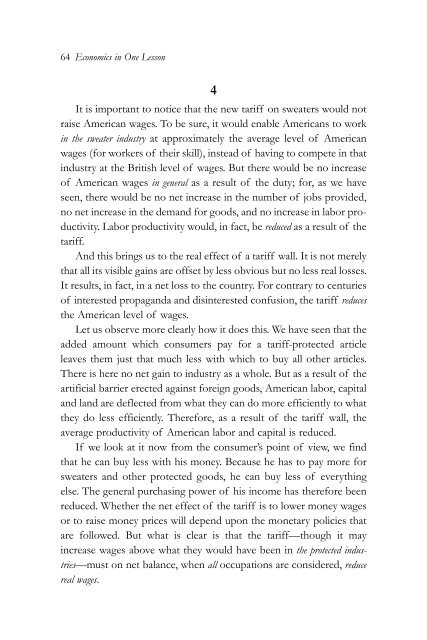1gDdM7w
1gDdM7w
1gDdM7w
- No tags were found...
Create successful ePaper yourself
Turn your PDF publications into a flip-book with our unique Google optimized e-Paper software.
64 Economics in One Lesson4It is important to notice that the new tariff on sweaters would notraise American wages. To be sure, it would enable Americans to workin the sweater industry at approximately the average level of Americanwages (for workers of their skill), instead of having to compete in thatindustry at the British level of wages. But there would be no increaseof American wages in general as a result of the duty; for, as we haveseen, there would be no net increase in the number of jobs provided,no net increase in the demand for goods, and no increase in labor productivity.Labor productivity would, in fact, be reduced as a result of thetariff.And this brings us to the real effect of a tariff wall. It is not merelythat all its visible gains are offset by less obvious but no less real losses.It results, in fact, in a net loss to the country. For contrary to centuriesof interested propaganda and disinterested confusion, the tariff reducesthe American level of wages.Let us observe more clearly how it does this. We have seen that theadded amount which consumers pay for a tariff-protected articleleaves them just that much less with which to buy all other articles.There is here no net gain to industry as a whole. But as a result of theartificial barrier erected against foreign goods, American labor, capitaland land are deflected from what they can do more efficiently to whatthey do less efficiently. Therefore, as a result of the tariff wall, theaverage productivity of American labor and capital is reduced.If we look at it now from the consumer’s point of view, we findthat he can buy less with his money. Because he has to pay more forsweaters and other protected goods, he can buy less of everythingelse. The general purchasing power of his income has therefore beenreduced. Whether the net effect of the tariff is to lower money wagesor to raise money prices will depend upon the monetary policies thatare followed. But what is clear is that the tariff—though it mayincrease wages above what they would have been in the protected industries—muston net balance, when all occupations are considered, reducereal wages.


